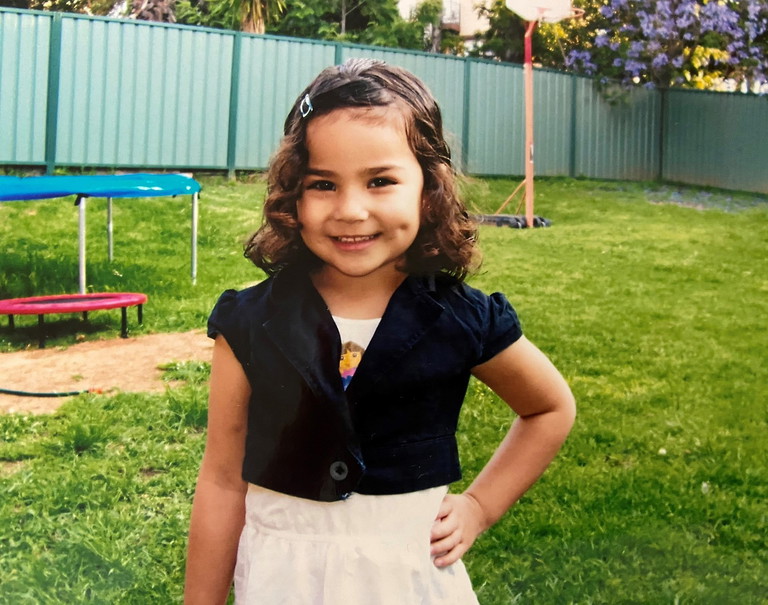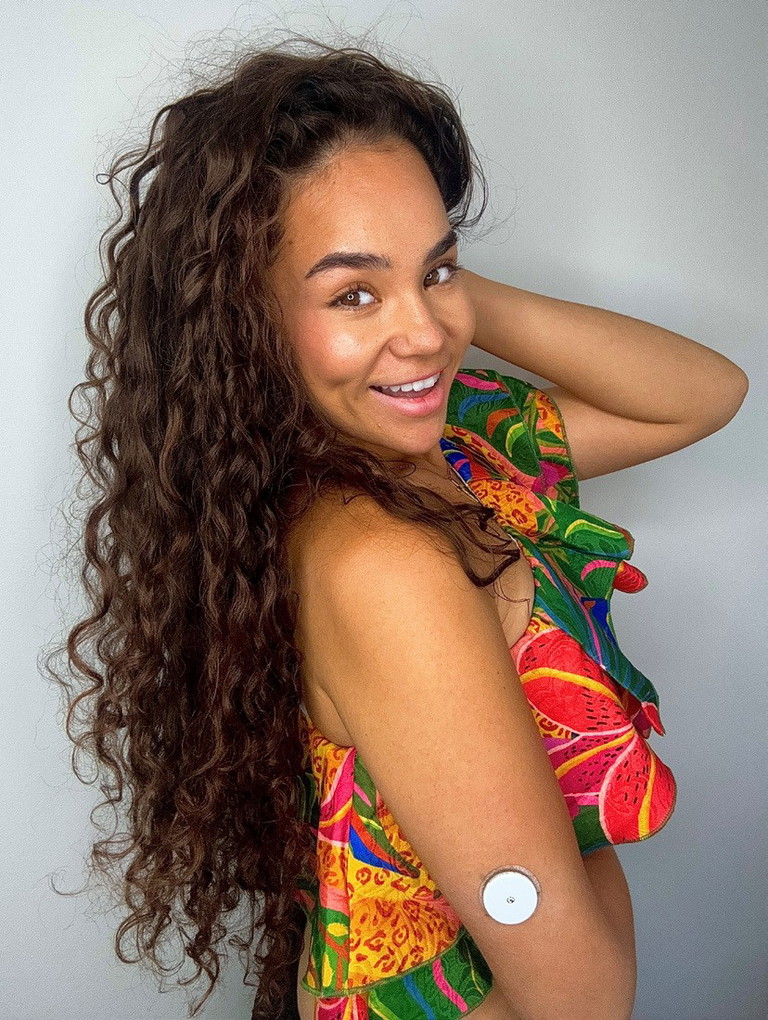mistory
Family, Faith, and
a Diabetes Reckoning

Amber Mauigoa at four and a half years of age.
Living with diabetes can be challenging at the best of times. But following her diagnosis at 17, the road to living well with diabetes for Amber Mauigoa has had many ups and downs.
WRITER Melanie Kell
At 21 years of age, Amber Mauigoa is navigating life with type 1 diabetes, a condition she never anticipated. One of nine siblings, she was diagnosed with diabetes at age 17, sending shockwaves through her family. With no family history of diabetes, the news came as an unexpected and overwhelming challenge, especially given her parents’ initial reluctance to accept medical intervention.
“We were one big, happy, healthy family, just living our lives,” she told mivision.
Due to religious beliefs, Amber’s parents urged her to avoid insulin therapy.
It was an emotionally exhausting time for Amber. With her parents refusing the insulin, her medical team chose to make direct contact with her, urging her to explain to her parents the importance of the treatment to manage the condition.
“Later I chose to take decisions regarding my health into my own hands – but at the time, of course, I wanted my parents’ support,” she said.
THE CRISIS CALL
The break came soon after Amber’s parents decided to move to Queensland. With a fulltime job in a call centre, she decided to stay in Sydney and rent a studio apartment.
But over time, without the insulin she needed to control her diabetes, Amber became increasingly ill.
“My insulin levels weren’t good because of my diabetes and to make things worse, I wasn’t eating well – I was eating a lot of sugar. I was getting really bad performance reviews at work, and thinking back, that was probably because my brain just wasn’t functioning well as my health worsened,” Amber told mivision.
“With everything else I had to learn about, no one told me that diabetes could affect my eyes”
“My brother called one day, and I must have sounded delusional. He asked me my name, my birthday, and I couldn’t tell him. I can clearly remember that I felt like I was dying. I felt like my soul was being sucked out of me.”
Three days later, emergency responders found Amber unconscious in her apartment. She was critically ill with diabetic ketoacidosis – a complication of diabetes resulting from increased levels of ketones in the blood that causes excessive thirst, frequent urination, fatigue, and vomiting.
THE CRISIS CALLTHE WAKEUP CALL
Amber spent the next two months in the intensive care unit of a hospital, being nursed back to good health. It was her wakeup call.
As she regained health, Amber became curious about diabetes and how she could manage it. She learned about the impact of food, exercise, and most importantly, how to monitor her glucose levels and manage her diabetes with insulin injections.
By the time she was discharged from hospital, she was ready to take charge of managing her condition.
TAKING CONTROL
Now, with continuous glucose monitoring and multiple daily insulin injections, Amber is working hard to maintain stable glucose levels. But it’s not easy.
“Diabetes has stopped me from working full time, because it’s like a full-time job in itself.
“I mean, if my insulin pump breaks or the batteries run out, or I leave my lunch at home, I either can’t eat for the day, or I’ve got to go home and get it. You never know when your sugars are just going to completely go in the opposite direction. I mean, I’ve taken insulin, but then had my sugar levels spike to 17.8 and become so sick that I’ve had to go home.”
KeepSight: Supporting Your Patient Care
The KeepSight programme, delivered by Diabetes Australia in partnership with the eye sector, is designed to increase the number of people with diabetes undergoing regular comprehensive eye examinations. In doing so, the programme helps detect eye problems that can lead to vision loss.
By sending reminders to registered patients, KeepSight makes it easier for people with diabetes to remember when they are due to get their eyes checked. The KeepSight reminders supplement existing recall and reminder systems within eye care practices.
As an eye care professional, you can help your patients with diabetes by introducing them to the KeepSight programme and, with this consent, registering them via Oculo or Optomate, or the KeepSight website (keepsight.org.au). Patients can also register themselves on the KeepSight website.
Once your patient is registered, you can record details of their eye check on the KeepSight website. This will ensure they are getting the right eye care, while also helping the National Diabetes Services Scheme (NDSS) to target people who are not getting recommended eye examinations to get checked.
Currently, over 600,000 people living with diabetes in Australia are registered to KeepSight. Can you add more?
Visit: keepsight.org.au
Amber’s day begins with a test of her insulin levels and a coffee, “then a healthy breakfast” before a visit to the gym.
To control her diet, she cooks all her own food at home, avoiding carbohydrates because “you need more insulin intake to balance carbohydrates, and insulin stores fat on the body: like all young women, I am concerned about my body image”.
Amber works part-time for the National Disability Insurance Scheme (NDIS) as a carer, a role that comes with four-hour shifts. She also works as a model, volunteers with Diabetes Australia as a spokesperson, and is a mental health advocate.
Working in this manner, she said, allows her to fit in her medical appointments and her exercise regimen, while also allowing time off for her wellbeing.
Each week necessitates at least two medical appointments, to which she travels by Uber.
Amber explained that she hasn’t got a driver’s licence because of the complications involved. According to austroads.gov.au, people with diabetes are legally obliged “to notify the driver licensing authority where driving is likely to be affected”.1
The rules are complex. While patients treated with glucose-lowering agents other than insulin may generally drive without licence restriction (i.e. on an unconditional licence), the driver licensing authority requires regular reviews.1

Amber Mauigoa at 21 years old.
People with insulin-treated diabetes (except gestational diabetes) are not considered fit to hold an unconditional licence, however “a conditional licence may be considered by the driver licensing authority subject to at least two-yearly review, taking into consideration the nature of the driving task and information provided by the treating doctor” with regard to particular criteria, including their risk and history of a “severe hypoglycaemic event”.1
Additionally, the condition must be reported to their motor vehicle insurer. And, because hypoglycaemia (low blood glucose) can affect your ability to drive safely, it is essential for a person with diabetes to closely monitor their blood glucose before driving, and at least every two hours on long trips. Health professionals are able to advise the driver licensing authority about a particular patient if they feel it necessary to do so.
“There’s a lot more to diabetes than people know about. My optometrist and the KeepSight programme have really helped me”
THE EYE CRISIS
It wasn’t until 2022 that Amber became aware of the long-term impacts that diabetes could potentially have on her vision.
Her endocrinologist triggered her interest in having her eyes tested.
“With everything else I had to learn about, no one had told me that diabetes could affect my eyes. I went along to the optometrist, as recommended, and he said he could already see damage to the vessels in my eyes (caused by the hospital episode). However, he said because I was young, and now that I had my diabetes management on track, they would repair. But he stressed the need to have regular eye examinations and showed me what could happen without them.”
After that first appointment, Amber started visiting Specsavers every two months, with appointments soon extended to every six months, once her optometrist was satisfied that her eyes were healing, and her diabetes management was being maintained. However, with so many appointments to keep, sometimes things can slip – especially if there are no obvious symptoms – and so, Amber registered for the KeepSight service.
“My optometrist and the KeepSight programme have really helped me,” she observed. “There’s a lot more to diabetes than people realise. But I feel I am managing my diabetes well now, and KeepSight reminders mean there is just one less thing to keep on top of,” she said.
HEALING RELATIONSHIPS
Now in her early 20s, and with her diabetes under control, Amber said her relationship with her parents has healed and become stronger than ever.
“I’m always posting online about my diabetes experiences, and my mother reads every post. As well, through her own research, she’s become so knowledgeable about diabetes management that she enjoys educating other people.”
Reflecting on her early experience with healthcare professionals, she said while they were very positive and did a great job, it was important that health care providers took into account a person’s broader life circumstances when navigating treatment and support.
“I know my parents were blindsided… no one expects to hear their teenager has diabetes.”
Through KeepSight’s reminders, Amber now stays on top of her eye health. Empowered with knowledge and a support system, she has a renewed sense of control over her health and is determined to keep her regular eye appointments.
Reference
1. Austroads. Assessing fitness to drive. (webpage) available at: austroads.gov.au/publications/assessingfitness-to-drive/ap-g56/diabetes-mellitus/medicalstandards-for-licensing-2[accessed May 2025].